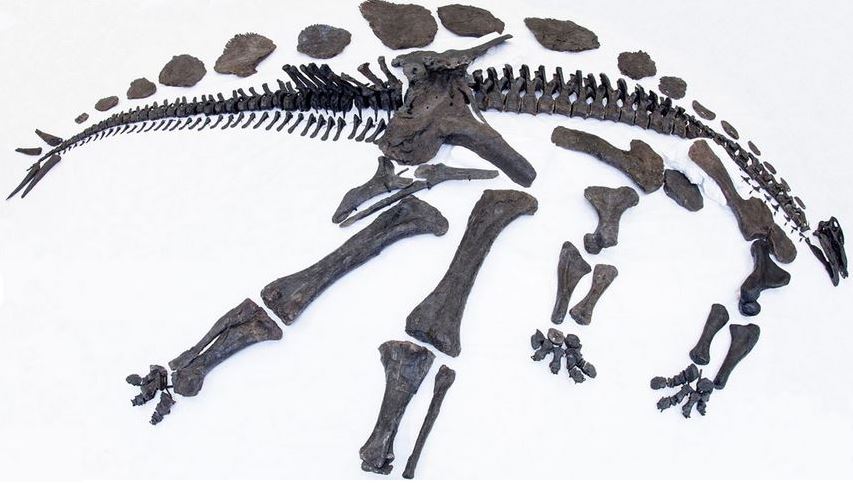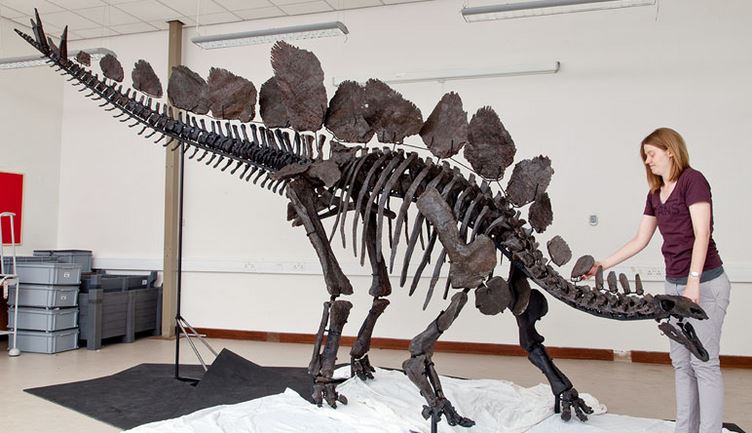A 150-million-year-old Stegosaurus weighed about 1.6 tones (1,600 kg, 3,527 lbs) when it was alive, the Natural History Museum in London announced on Wednesday, about the same as a small rhino.
The dinosaur that had a row of spiny plates on it back and tail spikes was revealed at the Museum in December. Its nickname is ‘Sophie’. It is an exceptionally well-preserved specimen, which will help scientists learn a great deal about the lives of stegosaurs.
Prof. Paul Barrett and Dr. Charlotte Brassey, who both work at the Museum, and Dr. Susannah Maidment of Imperial College London, estimated the animal’s weight by using a combination of a 3-D model of the skeleton plus more traditional techniques.

This artist’s reconstruction shows a Stegosaurus striking a Ceratosaurus with its spiky tail. (Image: Natural History Museum)
Dr. Brassey said:
“Because this incredible specimen is so complete, we have been able to create a 3D digital model of the whole fossil and each of its 360 bones, which we can research in excellent detail without using any of the original bones.”
Now they know how much it weighed, Dr. Brassey and colleagues can find out more about how Stegosaurus lived, such as how much food it needed and its walking speed.
Multiple methods
The research team used the 3-D model of the skeleton and fitted shapes around the bones to work out the volume of the Stegosaurus, before converting the amount to mass using estimates from living animals.
They then compared this method’s results with another commonly-used method that uses the circumference of the leg bone.
The second estimate calculated a result almost double that of the 3-D model estimate. However, since this specimen was only a young adult when it died, its legs had been growing at a faster rate than the rest of its body. When this was factored in, the two estimates agreed on a total body weight of about 1,600 kg.

In December 2014, the Natural History Museum unveiled the latest permanent addition to its public galleries – the almost complete skeleton of the iconic dinosaur Stegosaurus stenops. (Image: Natural History Museum)
Dr Maidment said:
“Calculating body mass in animals that have been dead for many millions of years is no easy task. Our study is the first to attempt different methods on the same animal, and has highlighted how and why different body mass estimation methods come up with different results. The age of the animal when it died is very important.”
Much to learn about body types
Their study explains why estimates based on leg-bone circumference and body volume often disagree in fossil studies.
Prof. Barrett said:
“These findings identify just how important exceptionally complete specimens like this are for scientific research and collections. We can use the same techniques on other complete fossils to find out much more about the wider ecology of dinosaurs.”
As the two methods’ results tally, the researchers are confident their estimate is accurate. However, they add that there is still a great deal to learn about the body types of dinosaurs.

The Museum’s new Stegosaurus has 19 bony back plates (one is a cast) and four vicious-looking tail spikes. (Image: Natural History Museum)
Stegosaurus’ anatomy would have been particularly unusual, given that they evolved from animals that initially walked on two legs.
Dr. Brassey said:
“Dinosaurs are related to modern birds and crocodiles, but their anatomy could have been quite different in some cases. The main muscles that would be used to pull the hind limbs backwards would have been pretty large and would have attached quite far down the tail. Combined with its wide hips, it’s fair to say this Stegosaurus probably would have had quite a large rear end.”
Video – Secrets of the Stegosaurus
